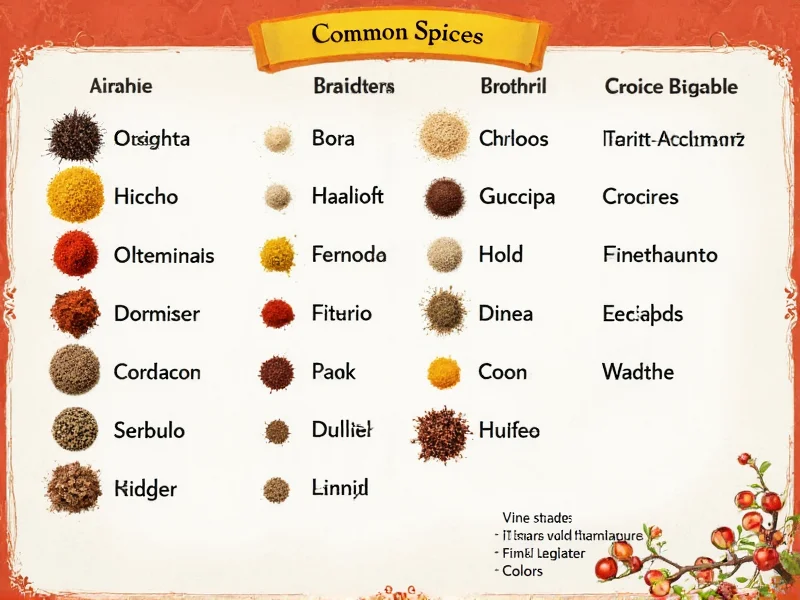Building a versatile spice collection transforms ordinary cooking into extraordinary culinary experiences. Whether you're a beginner cook or expanding your pantry, understanding which spices form the backbone of global cuisines saves time, money, and elevates your everyday meals. This comprehensive guide details the essential spices every kitchen should have, their flavor profiles, and practical usage tips.
Essential Spices Every Home Cook Should Have
Creating a functional spice collection starts with understanding which spices provide the most versatility across different cuisines. The following table organizes common spices into practical categories based on flavor profiles and culinary applications:
| Spice Category | Common Spices | Primary Flavor Profile | Best Culinary Applications |
|---|---|---|---|
| Warm & Sweet | Cinnamon, Allspice, Nutmeg, Cloves, Cardamom | Earthy, sweet, aromatic | Baking, chai, Middle Eastern dishes, braises |
| Savory & Earthy | Cumin, Coriander, Turmeric, Paprika, Sumac | Earthy, warm, slightly bitter | Curries, stews, roasted vegetables, marinades |
| Herbal & Bright | Oregano, Thyme, Rosemary, Basil, Dill | Fresh, grassy, floral | Tomato-based dishes, grilled meats, salads, dressings |
| Peppery & Pungent | Black Pepper, Cayenne, Chili Flakes, Ginger, Mustard Seed | Sharp, hot, stimulating | Adding heat, finishing dishes, spice rubs |
Building Your Basic Spice Collection
Start with these 10 foundational spices that cover most culinary needs. This essential spice list for beginners provides maximum versatility without overwhelming your pantry:
- Black Pepper - The universal enhancer that works in nearly every savory dish
- Garlic Powder - Provides consistent garlic flavor without burning
- Onion Powder - Adds depth to sauces, soups, and rubs
- Paprika - Offers color and mild sweetness (choose smoked for extra dimension)
- Cumin - Earthy backbone for Mexican, Indian, and Middle Eastern dishes
- Oregano - Essential for Mediterranean and Italian cooking
- Cinnamon - Not just for sweets; adds complexity to savory tagines and stews
- Turmeric - Earthy, slightly bitter spice with vibrant color and health benefits
- Chili Powder - A blend that adds warmth without overwhelming heat
- Dried Thyme - Versatile herb that stands up well to cooking
Understanding Spice Flavor Profiles
Knowing how spices interact transforms your cooking. The most used spices in world cuisine generally fall into three primary flavor categories:
- Warm Spices (cinnamon, nutmeg, allspice) - Create depth in both sweet and savory applications. These common spices used in cooking add complexity without heat.
- Earthy Spices (cumin, coriander, turmeric) - Form the foundation of many global spice blends. They provide the characteristic flavors of curry powders, taco seasonings, and garam masala.
- Bright Spices (sumac, za'atar, citrus zest) - Add acidity and freshness, often used as finishing spices to lift finished dishes.
Practical Spice Storage and Usage Tips
Proper storage maintains potency. Whole spices retain freshness for 2-4 years, while ground spices last 6 months to 2 years. Store all spices in airtight containers away from heat and light. For the most flavorful results:
- Bloom spices in oil before adding other ingredients to release essential oils
- Add ground spices early in cooking to mellow their flavor
- Add dried herbs mid-cooking, but finish with fresh herbs
- Toast whole spices before grinding for deeper flavor
Creating Your Personalized Spice Collection
Your ideal spice rack essentials checklist should reflect your cooking habits. If you frequently make Italian food, prioritize oregano, basil, and red pepper flakes. For Indian cuisine, focus on turmeric, cumin, coriander, and cardamom. The top 20 spices every kitchen should have varies based on your culinary preferences, but starting with the basic 10 provides remarkable flexibility.
Consider creating custom blends using your common spice list with descriptions. A simple homemade curry powder (equal parts turmeric, cumin, coriander, and ginger) or Italian seasoning (equal parts oregano, basil, rosemary, and thyme) costs pennies compared to store-bought versions and tastes fresher.
Frequently Asked Questions
How many spices should a beginner start with?
Beginners should start with 8-10 essential spices: black pepper, garlic powder, onion powder, paprika, cumin, oregano, cinnamon, and turmeric. This basic spice collection for home kitchen provides remarkable versatility across most global cuisines without overwhelming your pantry space.
Which spices go bad the fastest?
Ground spices lose potency faster than whole spices. Paprika, chili powder, and ground ginger typically degrade within 6-12 months. Whole spices like cinnamon sticks, peppercorns, and cumin seeds maintain freshness for 2-4 years when stored properly in airtight containers away from heat and light.
What's the difference between similar spices like cumin and caraway?
While visually similar, cumin has a warm, earthy, slightly smoky flavor essential in Mexican and Indian cooking. Caraway offers a distinctive licorice-like note common in European rye breads and sauerkraut. Turmeric provides earthy bitterness and vibrant color, while saffron delivers floral notes and golden hue at a much higher price point. Understanding these distinctions prevents recipe mishaps.
Can I substitute fresh spices for dried in recipes?
Generally use three times the amount of fresh herbs compared to dried, as drying concentrates flavors. For example, 1 teaspoon dried oregano equals 1 tablespoon fresh oregano. Fresh spices like ginger or garlic have brighter, sharper flavors than their dried counterparts, so adjust to taste. Some spices like mustard seed or cumin only work effectively in their dried form.
How can I tell if my spices are still fresh?
Perform the smell and color test. Fresh spices should have a strong, distinctive aroma when rubbed between your fingers. If you must bring the container close to your nose to detect any scent, they've lost potency. Vibrant colors indicate freshness—dull or faded spices have degraded. For spices like paprika or turmeric, rub a small amount on a white paper towel; fresh spices will leave a strong color stain.











 浙公网安备
33010002000092号
浙公网安备
33010002000092号 浙B2-20120091-4
浙B2-20120091-4